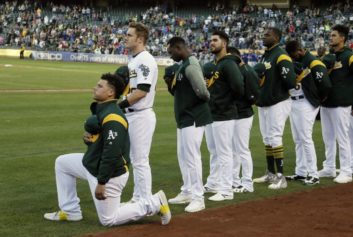Baseball season opened Monday. Did you notice?
If you happened to, you likely wondered: Where are the Black players?
Here’s the answer: Not playing baseball.
Since 1986, the percentage of African-Americans in the Major Leagues has dropped more than half, from 19 percent to 8.5 percent.
Clearly, the game is truly America’s pastime, not Black America’s pastime.
Over the years, baseball’s executive office has implemented programs to grow the game in urban communities, make it more accessible and intriguing to young African-American males.
Hasn’t worked.
So, that leaves a question: Why?
No one seems to have the concrete answers that can effect change. This much can be believed: The symptoms of the problem are not the causes of the problem.
In announcing a task force to look into the lack of diversity in his game in 2013, then-commissioner Bud Selig said: “As a social institution, Major League Baseball has an enormous social responsibility to provide equal opportunities for all people, both on and off the field.”
Translation: Baseball has not been doing the job.
Know what the task force found out? Nothing we didn’t already know: The sport is hurting in urban areas because of the high cost of equipment, “insufficient exposure to leagues” and training facilities, a shortage of scouts and experienced coaches and fewer scholarships available to baseball players.
Those are the symptoms of the problem. The causes are a different thing altogether. The causes reflect socioeconomic disparities.
Pittsburgh Pirates outfield Andrew McCutchen, who is Black, said to the Chicago Tribune: “I think the economy itself has to change. The rate of single-parent families in the black community is drastic, and that has a lot to do with (fewer Black kids playing baseball). You have to make a lot of sacrifices in this game to be able to play, especially as a young kid and especially in those colder states, where you don’t get baseball (in the spring) and you have to have money to play for a team that travels. And that’s hard, especially in a single-parent home, with a mom or dad with a countless amount of jobs and two or three kids or more.”
“It’s hard to do,” he added. “I had a lot of sacrifices made for myself, but my family stayed together. I’m not saying you can’t make it in a single-parent family, but it’s very difficult.”
And there you have it. Like most everything else, to truly develop and get exposure in sports today, money is a major player.
Like AAU basketball and the other “Sneaker Leagues,” travel-team baseball for youths is pricey and requires a commitment from parents to get the kids to/from practice and games.
It’s a burden that, coupled with the exorbitant rates for uniforms, gloves, helmets, spikes, can make for a financial strain.
Baseball’s RBI program to attract inner-city young athletes has had mixed results. Selig touted it as a success, but the numbers do not bear it out.
Jimmy Rollins played in NorCal Baseball, one of the most successful, respected and inclusive travel-ball organizations in the country. The New York Daily News asked him about how its impact has influenced the game for Black youths, Rollins’ response told it all:
“RBI. Whatever.”
Baseball for youths has become an industry, and so individual instruction has come into the fold. If you want a hitter, he has to pay for specialized training. Want a keen fielder? Specialized training. Pitcher? Same deal.
Unfortunately, it has become common that parents of the kid with super talent or potential bypass Little League and drop him in a traveling program that—get this—plays up to 130 games a year. And, of course, that costs significant money and time.
LaTroy Hawkins, who has played in the Majors for years, told Sports Illustrated: “Baseball in the United States has become a sport for the rich.”
And since the wage gap is decidedly lopsided—and not in the favor of African Americans—fewer Black kids who would be interested in the game have parents who can afford it.
SI pointed out: “When you look at the schedules involved — games 20 miles away at 4 p.m., games 30 miles away under lights at 7 p.m. . . how (could) any kid can meet the obligations of these leagues without having at least one full-time stay-at-home parent who will pick the kid up at school and schlep them out to wherever. Run those obligations against whatever socio-economic demographic numbers you can find and you’ll see why these sports select for well-off white kids.”
Pretty soon, it will be Jackie Robinson Day in the Majors. Every player will wear his No. 42 in honor of the man who broke baseball’s color barrier. It’s a cherished acknowledgement. Just too bad 91.5 percent of the players donning his number will not look like him.



